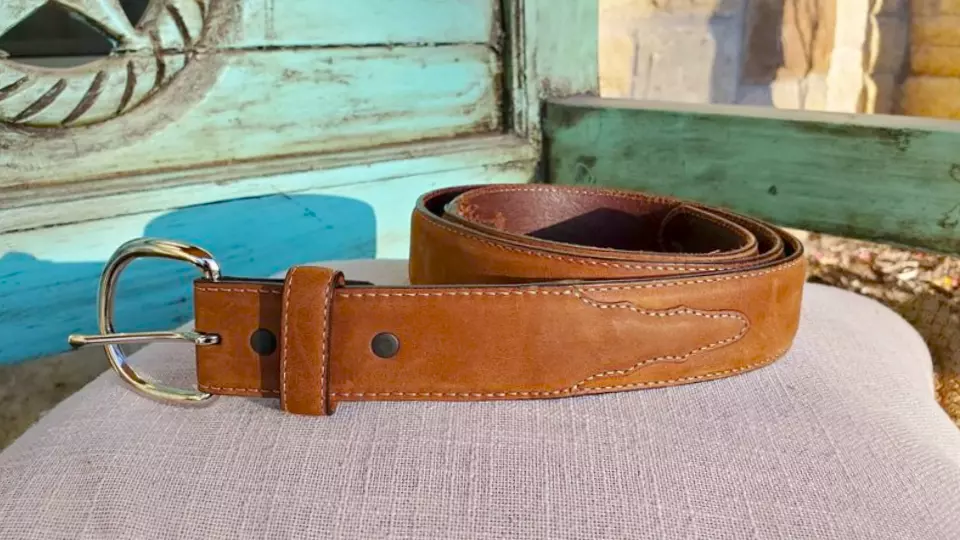How to Break in & Soften a Leather Belt
A new leather belt isn’t only there to hold up your skirt or pants – it can also elevate your entire outfit and make you look chic and classy. However, new leather belts feel uncomfortable to wear since they are incredibly stiff and rigid.
Old leather belts can also harden over time, especially if they are not maintained properly or when they are constantly exposed to the elements, including harsh sunlight and water.
These elements can dry out leather by drawing out the moisture from within and leaving the material stiff. The solution to these problems is breaking in new belts and softening old hardened ones using proper techniques.
The best methods to soften a leather belt is to use a leather conditioner, an alcohol and petroleum jelly solution, some natural oils, or through continuous wear. This article will detail different methods for softening new and old leather belts by restoring suppleness through natural methods.
Method 1: Leather Conditioner
A leather conditioner is a great way to soften and restore the original suppleness of an old leather belt. The nourishing ingredients of a leather conditioner (we recommend the Leather Honey Leather Conditioner or anything similar), penetrate the tough and hardened layers of leather.
These nourishing ingredients get absorbed through the pores of the leather, making it more malleable and flexible. It may also slightly darken the leather belt, giving it a supple and polished appearance.
For new leather belts, the leather conditioner seeps into the layers and removes any extra friction present between them. It can also prevent any staining in the future and enhance the patina of old leather.
For this process, you will need:
- Lint-free, clean microfiber cloth
- Leather-friendly conditioner
How to Use a Leather Conditioner to Soften Leather Belts
To soften your leather belt using a leather conditioner, you need a clean and dry microfiber cloth and your choice of suitable leather conditioner. Start by cleaning the leather belt and ensuring it is free of all impurities before conditioning it.
Apply the leather conditioner to your leather belt using a clean cloth and let it dry completely after applying one coat. Also remember to ensure that the coat is even and that you cover all parts of your leather belt (the top and bottom sides, end tip, and belt loop).
If you’re dealing with an older leather belt that has significantly stiffened, soften it by repeating the process multiple times, until you are satisfied with the result (It should show suppleness and a polished appearance).
Method 2: Rubbing Alcohol & Petroleum Jelly
Using rubbing alcohol in combination with petroleum jelly (such as Vaseline) can help soften your leather belt, as well. No matter if your leather belt is new or old, rubbing alcohol can clean the leather surface and open up the material’s pores.
After applying rubbing alcohol, you’ll need to apply a layer of petroleum jelly onto the leather belt. The mineral oils and waxes found in petroleum jelly will soften the tense leather fibers and lubricate them for more malleability and suppleness.
For this process, you will need:
- Cotton balls
- Petroleum jelly
- Rubbing alcohol
- Dry clean cloth
How to Use a Rubbing Alcohol & Petroleum Jelly to Soften Leather Belts
Use a cotton ball to apply a large quantity of rubbing alcohol to your leather belt’s surface. This step will open up the pores of the leather and remove any impurities present.
After this, you’ll need to apply a few coats of rubbing alcohol to ensure it has been soaked by the leather. Don’t let it soak for too long – a couple of minutes will do the trick here.
We then recommend using your fingers to apply a thin layer of petroleum jelly on your leather belt so that the fibers of the belt can relax. Too much petroleum jelly can cause a sticky and gooey mess on your leather belt; therefore, ensure you use it sparingly.
You can use any type of petroleum jelly – we typically stick to the trusted Vaseline. Wipe any excess petroleum jelly on the belt away with a clean cloth. Remember to allow the belt to dry completely before your next use.
Method 3: Natural Oils
Natural oils are highly effective in penetrating the layers of old leather and replacing the lost essential lubricants. They can also seep into new leather belts to relax the tightened leather fibers and help them become more malleable and supple for use.
Some of the most common natural oils you can use to soften your favorite leather belt include the following:
- Mink oil (preferred)
- Neatsfoot oil (may slightly darken leather)
- Coconut oil (may slightly darken leather)
- Avocado oil
- Almond oil
- Olive oil
- Jojoba oil
For this process, you will need:
- Lint-free cloth
- Your choice of natural oil
How to Use Natural Oils to Soften Leather Belts
To allow the oils to penetrate the leather effectively, we suggest that you heat up the natural oils slightly. Do not heat up your leather by using a hairdryer or by placing it underneath the sun, even though other sources may recommend this.
After heating up your choice of natural oil, apply it to the leather surface using a lint-free cloth or your fingers. We prefer using our fingers for the process since it will help you get into the edges and the other components of your belt more easily. Allow your leather belt to dry completely after having applied an even layer.
Method 4: Regular Wear
New leather products often become stiff after the tanning process but can begin to soften through regular wear. When wearing your leather belt, you expose it to stress, which causes the fibers of the leather to relax over time.
This allows your leather belt to soften and become more flexible. However, you should take note that excessive wear or exposing it to too much stress may actually damage it in the long run and cause it to crack and peel.
How to Wear Your Belt to Soften It
To soften your leather belt by wearing it, you should first make sure that it has a snug fit around your waist. This will cause tension in the fibers of your new leather belt and allow them to loosen up.
You can also manually bend and break in your leather belt by stretching it slightly. Place your leather belt in both hands, keeping your hands close to each other.
Form fists around the belt and gently twist your fists inwards to stretch small sections of your leather belt. This will cause your leather belt to become more malleable and soft.
If you plan to stretch your leather belt by wearing it, we suggest that you apply a leather conditioner to achieve better results and also to protect your belt from forming wrinkles and creases.
Additional Tips for Softening & Breaking In Your Leather Belt
There’s a fine line between softening your leather belt and overstretching it to a point where it forms creases and starts peeling. Therefore, it’s important to understand some key aspects of what to avoid and what to pay attention to. Let’s explore them in a little more detail.
- Maintain Your Leather Belt Regularly – Regular cleaning and conditioning of your leather belt can prevent any stiffness, dryness, and peeling. Clean and condition your belt at least once a month to ensure it remains soft, supple, and shiny for a long time.
- Use Only Leather-Friendly Products – Leather-friendly products contain safe and natural ingredients that do not harm the texture, color, or look of your leather belt. They can prevent any accidental damage and ensure that it will last for years to come.
- Be Patient – If your leather belt is still stiff after using the aforementioned softening methods, you’ll need to be a little more patient and give it some time. Certain types of leather take time to soften and will become more supple with regular maintenance.

About Gerrit
Co-Founder, Researcher & Writer At Leatherskill
I’m a leather enthusiast who spends most of his free time crafting, researching, and writing about the many facets of this versatile material. Thanks for reading!

